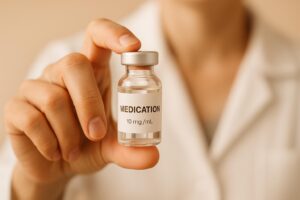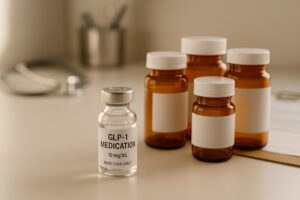Ozempic vs Compounded Semaglutide: Costs Explained

When it comes to weight management or managing type 2 diabetes, medications like Ozempic and its compounded alternative, compounded semaglutide, are generating buzz. Both rely on the same active ingredient, semaglutide, to help regulate blood sugar, reduce appetite, and support weight loss. However, their costs and accessibility vary dramatically, leaving many people confused about which option is best for their health and their wallets.
This article unpacks the differences between branded Ozempic and compounded semaglutide, explaining their costs, effectiveness, and potential pricing pitfalls. By the end, you’ll have the clarity you need to make informed decisions about your treatment plan without falling victim to financial surprises.
What Is Semaglutide?
Before diving into pricing, let’s start with the basics. Semaglutide is the active ingredient in both Ozempic and its compounded version. It belongs to a class of drugs called GLP-1 receptor agonists, which mimic a hormone that:
- Signals the pancreas to release insulin when blood sugar levels are high,
- Slows digestion, helping you feel full longer, and
- Sends signals to the brain to reduce appetite.
The critical takeaway here is that both Ozempic and compounded semaglutide work the same way in the body because they share the same active ingredient.
Branded Ozempic: The Luxury Option

Ozempic is the branded version of semaglutide, manufactured by a single pharmaceutical company. While it’s a highly effective and well-researched medication, its high price often makes it inaccessible for many patients.
Why Is Ozempic So Expensive?
- Patented Drug: Ozempic’s manufacturer holds the patent, meaning only they can produce and sell it under this brand name.
- Decades of Research and Marketing: The price includes the cost of clinical trials, decades of research, and marketing campaigns.
- Specialized Delivery: It comes in a pre-filled injection pen, adding to its production costs.
Cost Breakdown
Without insurance, Ozempic typically costs $1,200 to $1,500 per month. This high price has made patients and healthcare providers alike consider alternatives.
Compounded Semaglutide: The Affordable Alternative
Compounded semaglutide offers a more budget-friendly option for those who need access to semaglutide but cannot afford the branded medication. Here’s how it works:
What Is Compounded Semaglutide?
Compounded semaglutide is produced by FDA-registered compounding pharmacies in the United States. These pharmacies create smaller batches of the drug, using the same active ingredient as Ozempic.
Cost Advantage
Compounded versions typically cost $200 to $400 per month, depending on the pharmacy and provider. This significant price reduction makes semaglutide more accessible to a wider audience.
Why Is It Cheaper?
The lower cost stems from compounding pharmacies not having to pay for branding, large-scale production, or marketing. However, compounded medications are legally allowed only when the branded drug is on the FDA’s shortage list, as is the case with Ozempic, due to high demand.
Do Ozempic and Compounded Semaglutide Work the Same Way?
Yes, both medications are equally effective because they share the same active ingredient: semaglutide. Both regulate appetite and blood sugar, delivering comparable results.
However, patients should always consult with a licensed healthcare provider to ensure compounded medications are sourced from reputable, FDA-registered pharmacies.
The Hidden Costs: Watch Out for Pricing Traps
For many patients exploring GLP-1 options, the biggest surprise isn’t the medication itself – it’s the pricing traps used by some providers. Here’s what to watch for:
The Bait-and-Switch Model
Many companies advertise GLP-1 treatments at starting prices as low as $150 per month, but these are often tied to your initial low dose. As treatment progresses and your dosage increases, so does the cost. This predictable increase can leave patients paying $450 or more per month within a few months.
Additional Hidden Fees
Beyond dose-dependent pricing, some providers tack on extra charges that inflate the total cost, including:
- Consultation fees: $50–$100 for prescription renewals,
- Shipping fees: $15–$30 per month, and
- Program or membership fees: $50–$100 for clinical support or coaching.
Long-Term Budgeting Challenges
These hidden costs create financial uncertainty, making it difficult for patients to plan long-term. Many patients abandon treatment when prices become unmanageable, derailing their weight loss progress.
How to Choose the Right Provider
To avoid financial surprises and ensure safe, effective treatment, ask potential providers these essential questions:
- Will my monthly price increase as my dose increases?
- Look for providers offering transparent, fixed pricing.
- What’s included in the advertised cost?
- Confirm whether it covers the medication, consultations, shipping, and support.
- Are there any hidden fees?
- Watch out for extra charges for consultations, shipping, or mandatory memberships.
- What medical oversight is provided?
- Ensure you’ll have access to licensed healthcare professionals for dose adjustments, side effects, and clinical support.
Red Flags to Avoid
Be cautious of providers offering prices below $150 per month. While the low cost might seem tempting, it often signals major risks, including:
- Questionable sourcing: Medication may come from overseas, unregulated pharmacies.
- Lack of medical oversight: You may not receive proper care or clinical consultations.
- Hidden fees: The low price may be a hook to trap you into paying more later.
Key Takeaways
- Ozempic vs. Compounded Semaglutide: Both contain the same active ingredient and work identically in the body, but compounded versions are significantly cheaper.
- Pricing Differences: Ozempic costs $1,200–$1,500 per month, while compounded semaglutide ranges from $200–$400 per month.
- Avoid Pricing Traps: Some providers use low starting prices as bait, with costs rising as dosages increase. Watch for hidden fees!
- Ask the Right Questions: Before committing, ensure you understand the provider’s pricing structure, inclusions, and medical support.
- Choose Safety First: Only work with FDA-registered compounding pharmacies and licensed medical providers.
Final Thoughts
Navigating the world of GLP-1 medications can feel overwhelming, but understanding the differences between Ozempic and compounded semaglutide is a great starting point. The right choice depends on your health needs, budget, and commitment to long-term treatment. By asking the right questions and avoiding common pricing traps, you can find a solution that works for both your health and your wallet.
Stay informed, stay empowered, and prioritize transparency and quality when selecting your provider. Your journey to better health begins with clarity and confidence.
Source: “How Much Does Ozempic Really Cost?” – TrimRx, YouTube, Nov 7, 2025 – https://www.youtube.com/watch?v=Uv8Ch5wrOhg

Transforming Lives, One Step at a Time
Keep reading
Ultimate Guide to Semaglutide Dose Customization
This guide explores semaglutide dosing for diabetes and weight loss, emphasizing personalized adjustments for optimal results.
6 Common Drug Interactions with GLP-1 Medications
Learn about six common drug interactions with GLP-1 medications and how to manage potential risks for safe treatment.
Mounjaro Insurance Coverage: What to Know
Learn how insurance coverage for Mounjaro varies based on diabetes treatment and weight loss, along with tips for approval and cost-saving options.
Semaglutide vs. Tirzepatide: Max Dose
Explore the differences between two weight loss medications, their maximum doses, effectiveness, and safety profiles for better health outcomes.
GLP-1 Diet Plan: 7-Day Meal Guide
Learn how to effectively pair GLP-1 medications with nutritious meal planning for weight loss, improved digestion, and stable blood sugar.
Nausea and GLP-1 Medications: Solutions That Work
Learn effective strategies to manage nausea from GLP-1 medications, including dietary tips and the importance of personalized dosing.
5 Signs GLP-1 Medication Is Working for You
Learn the key signs that indicate your GLP-1 medication is effectively aiding weight loss, appetite control, and blood sugar management.
Plateau Problems: Restarting Weight Loss
Stalled weight loss on GLP-1 medications is common but manageable. Explore strategies to break through plateaus and regain momentum.
Body Fat Percentage Estimator – Know Your Stats
Estimate your body fat percentage in seconds with our free tool. Just input your height, weight, and more for instant results. Try it now!









